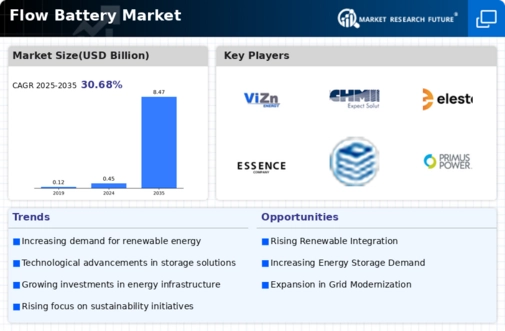Top Industry Leaders in the Flow Battery Market

*Disclaimer: List of key companies in no particular order
The landscape of energy storage is undergoing rapid transformations, with flow batteries emerging as a promising solution for long-duration applications. As the flow battery market evolves, a diverse array of players is entering the scene, each employing unique strategies to establish and fortify their positions. Navigating this dynamic environment requires a comprehensive understanding of market share dynamics and a keen awareness of emerging trends.
Strategies of Key Players:
Large Established Companies: Major players in the battery industry, such as Samsung SDI and Panasonic, are leveraging their extensive infrastructure and research and development capabilities to focus on the commercial maturity of vanadium redox flow batteries (VRFBs). Their strategy revolves around refining existing designs and enhancing cost-competitiveness.
Startups and Spin-offs: Nimble newcomers like ESS Inc. and Imergy Power Systems are pushing the boundaries of innovation by exploring alternative chemistries like zinc-bromine (ZnBr) and organic flow batteries. Their agility allows them to adapt quickly, prioritizing specific niche applications.
Consortiums and Partnerships: Collaborative efforts are prevalent, with industry giants like Sumitomo Electric and General Electric forming partnerships to combine expertise and accelerate technology development. Additionally, research institutions and universities are collaborating with established companies to bridge the gap between academia and commercialization.
Factors Influencing Market Share:
Technology Portfolio: A company's market share potential is influenced by the breadth and variety of flow battery chemistries in its portfolio. Companies offering diverse solutions for various applications are better positioned to capture a larger market share.
Geographical Reach: The ability to penetrate key markets, especially in Asia Pacific and North America, plays a significant role in achieving market dominance. Establishing strong regional partnerships and understanding local market dynamics are critical factors.
Manufacturing and Supply Chain: Cost-effective manufacturing capabilities and a robust supply chain for essential materials like vanadium or zinc are crucial for a company's price competitiveness and scalability of production.
Project Track Record: A proven track record of successful flow battery deployments in real-world applications builds trust and attracts potential customers. Demonstrating the reliability and performance of their technology through case studies enhances market share potential.
New and Emerging Trends:
Beyond Vanadium: While vanadium redox flow batteries (VRFBs) currently dominate the market, alternative chemistries like ZnBr and organic flow batteries are gaining traction due to their lower cost and inherent safety advantages. Companies actively researching and developing these technologies are well-positioned to tap into new market segments.
Grid Integration and Smart Systems: Flow batteries are increasingly integrated into smart grids, providing grid stabilization and peak shaving capabilities. Companies offering integrated energy management solutions that combine flow batteries with renewables and software platforms gain a competitive edge.
Miniaturization and Modularization: Reducing the size and weight of flow batteries opens up new application possibilities, particularly in microgrids and distributed energy systems. Companies focusing on innovative design solutions and modularity benefit from this trend.
Overall Competitive Scenario:
The flow battery market presents a dynamic and fragmented landscape, with established players, ambitious startups, and strategic partnerships vying for market share. While VRFBs currently lead, innovative companies exploring alternative chemistries are poised to disrupt the status quo. Success will hinge on technological leadership, cost competitiveness, strong partnerships, and the ability to cater to diverse market needs. As the grid undergoes transformation and the demand for long-duration energy storage rises, the flow battery market promises to be an exciting space to watch in the coming years.
Industry Developments and Latest Updates:
ESS Inc. (US): Announced a partnership with Microsoft on December 15, 2023, to deploy its iron flow batteries in data centers, supporting renewable energy integration and grid resilience.
Gildemeister Energy Solutions (Austria): Unveiled its new Gen3 vanadium flow battery on October 26, 2023, with increased energy density and improved efficiency.
Redflow Limited. (Australia): Successfully demonstrated its zinc-bromine flow battery in a microgrid project in Indonesia on December 21, 2023.
Primus Power (US): Commissioned a 2 MW/8 MWh vanadium flow battery system for peak demand reduction in California on December 19, 2023.
Sumitomo Electric Industries, Ltd. (Japan): Showcased its new redox flow battery technology with improved performance and reduced cost at the Battery Japan exhibition on October 20, 2023.
Vizn Energy Systems. (US): Completed a successful pilot project of its zinc-iron flow battery system for off-grid power generation in Hawaii on December 12, 2023.
Top Companies in the Flow Battery Industry:

